Rapid multiple borrowings: Riviera style today
By Tony Sylvester.
“On the pleasant shore of the French Riviera, about half way between Marseilles and the Italian border, stands a large, proud, rose-colored hotel. Deferential palms cool its flushed façade, and before it stretches a short dazzling beach.
“Lately it has become a summer resort of notable and fashionable people; a decade ago it was almost deserted after its English clientele went north in April.”
So begins F Scott Fitzgerald’s 1934 novel Tender Is The Night, his tale of American ex pats en residence amongst the palms, firs and golden beaches of the Cote D’Azur at the twilight of the Jazz Age - that fertile era of excitement and enchantment between the wars.
Almost a century later the term ‘Riviera’ still resonates: a shorthand for glamour and relaxed opulence that the novel helped foster, alongside Hemingway’s The Garden Of Eden, Sagan’s Bonjour Tristesse and others, and the nascent celebrity gossip industry that fed the public’s appetite with photos of the rich and famous at play.
What Fitzgerald says is correct. The hotel he fictionalised for the novel, The Hotel Du Cap in Cap d’Antibes, had always shut from May to September, following the vogue for the Riviera being a resort for wintering Brits.
They began popularising the benefits of winter sun there in the 1880s, following the arrival of the railway from Paris, extending the Victorian tradition of the healthy beach visit to further flung places.
Then in the mid-1920s, Cole Porter rented a chateau down the road from Hotel Du Cap for the summer, and the Americans started to arrive in force, intermingling with English aristos, Russian emigres, local artists and the cream of Paris society. This encouraged hotel owners to stay open for this faddish new endeavour.
Here we hand over to Farid Chenoune, the French menswear writer: “American socialites not only frequented Palm Beach, Newport, Nassau, et al but could also now be found on the French Mediterranean Coast where rich, sun seeking Europeans (notably English) vacationed during the interwar period. It was thus in the early 1930s that the Riviera became a fashionable spot for spring and especially summer holidays whereas in the past it had been a winter resort.
“In terms of the history of fashion, this shift represented the coming of age of summer as a fully fledged “season” in itself.” They were witnessing not only the birth of idea of the ‘summer season’ but also the invention of the clobber that went along with it.
As well as the tabloid press, we’re lucky that we have contemporary menswear publications such as the industry-targeted Apparel Arts and more customer-friendly Esquire, to give us an insight into what these new vacationers were wearing.
What’s interesting to me now is that 10 decades later, many of the clothes look not only modern, but thoroughly practical and sound. Not the whole outfits, of course, but pieces from each image.
As Chenoune goes on to explain, “Summer fashion spread from one spot to another, like pollen carried by a swarm of cosmopolitan bees. This explains its cross-bred, international nature, the product of rapid multiple borrowings from fishermen’s gears, sailors’ uniforms, sports clothing and colonial dress (both military and civilian). In this respect, summer clothing was already more modern than any other…”
I am fortunate to own a couple of summer issues of Apparel Arts from the period (1932 and 1933) and the contemporary resonance is striking. Apart from one-piece wool bathing suits, there is little that would be out of place in today’s holiday wear rotation. I would have added men’s lace-up espadrilles to the list, but that’s my particular preference.
Some of the pieces Chenoune lists are:
- Summer suiting(in seersucker, shantung, linen and ‘palm fibre’)
- Gaberdine, blazers, bush shirts(safari jackets)
- Polo shirts, sailor smocks
- And perhaps the only anachronism of the bunch, the ‘Spencer’ or mess jacket - essentially a dinner jacket cut short like a bolero, or a tailcoat without tails.
The key to referencing Riviera style today is probably maintaining a level of relaxed formality, while using cloth, colour and texture to demonstrate the difference from a workaday wardrobe - in a similar manner to the difference between a lounge suit and a dinner suit for example.
There are also clothes suited to the beach and sunbathing - shorts, trunks, flip-flops, but here I’m more concerned with dressing away from the water, for the day or evening.
The contemporary photographs of the day, the wealth of advertisement images in those magazines, and the evocative illustrations from the likes of Laurence Fellows and Robert Goodman can all be used to help build looks.
The first and perhaps most obvious choice is the selection of an odd jacket and trousers rather than a suit. This is perhaps the most striking change from the English holidaymakers of the late Victorian age to post-WWI travellers.
The English still holidayed in two-piece suits of linen or light wool, paired with starched collars, ties and dress shoes - so the only differences between their lounge suits in town and their holiday clothes were the lighter weight and paler palette. The swapping for odd jackets of visibly tactile and slubby cloths - raw silk, dry weave ‘Panama’ wools and even Terry cloth - made for an instantly visible leap forward.
This goes hand in hand with the other main trend: splitting colour across an outfit, instead of keeping a uniform tone. Darker jackets were suddenly paired with light trousers and vice versa.
This is seen most obviously in the illustrations of Fellows and Goodman, rather than the black and white photos of the day (an issue we encountered before in the PS article on colour and culture).
Fellows pairs coral trousers with ecru jackets, tan shirts with forest green slacks, as well as showing the more accepted maritime palette of navy with cream. Very few of the gents drawn are in a singular hue.
Other guidelines are similar to the idea of holiday-specific tailoring materials. Shirts should be specific and seasonal, not simply dress shirts unbuttoned. A band collar or open lido-collar work well in this department.
Similarly, while ties are restrictive and impractical the overall accord often misses that pop of colour and pattern. The most obvious answer is a silk or cotton scarf, which is best tucked behind the collar rather than sprawled out across the chest. Think Cary Grant in To Catch A Thief: his red-and-white neckerchief provides just enough visual lift behind the stripe of the round-neck matelot knit, without overpowering everything else.
For footwear, it’s possible to keep the benchmade quality but dial down the formality. Unlined loafers are the obvious choice, but I would make the case for closed-toe sandals as well.
Sadly, not many of the big names make them for men these days - Edward Green used to have the ‘Rangoon’ model and John Lobb the ‘Olympe’, but like most good things, they seem to have vanished.
While Cheaney, Church’s and Ralph Lauren still do versions, I was happy to see Ludwig Reiter add the ‘Triestiner’ model to their catalogue this summer, a closed-toe sandal on a particularly nice, elegant last in brown or black perforated calf. This is absolutely the ticket, worn socked or sockless, and I prefer the black colour myself - not the usual choice for summer months, but it does give me the most options across my wardrobe.
More casual footwear can be added, if approached with caution. Espadrilles are a strong candidate (Manish’s piece was a nice in-depth look) and I’m rather fond of CVOs - cotton vulcanised oxfords, which appeared around the same pre-war time we’re referencing, morphing into the ubiquitous deck shoe over time.
Of course, despite having this historical road map, there is no substitute for hard fought experience; trial and error. I shudder when I recall one personal outfit that fell very much on the side of error.
Invited to a summer wedding in Liguria years ago, I delved into my somewhat dilettantish sartorial knowledge of the time and came up with a cream-linen suit from Mark Powell, with peaked lapels and a slight kick flare to the trouser, worn with a white penny-collared dress shirt, purple knit tie and tan bucks.
It was a disaster. I was trying to emulate the spirit of the jazz age but overdid it. Compare that to the photo from last summer below, with a black fresco blazer worn with white herringbone slacks and espadrilles, and I think the result is much more harmonious.
Free and easy, that’s the key.


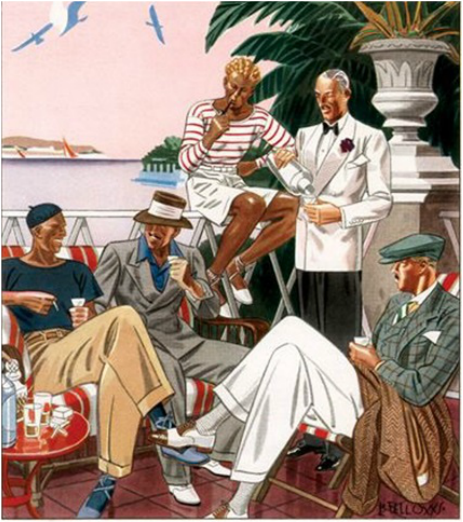
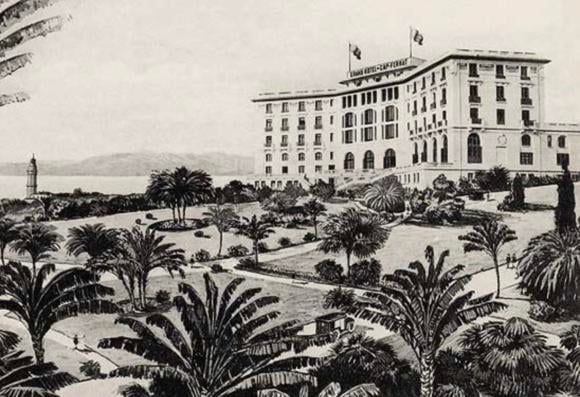
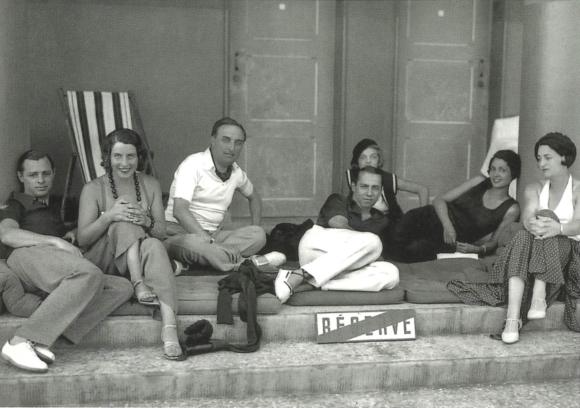
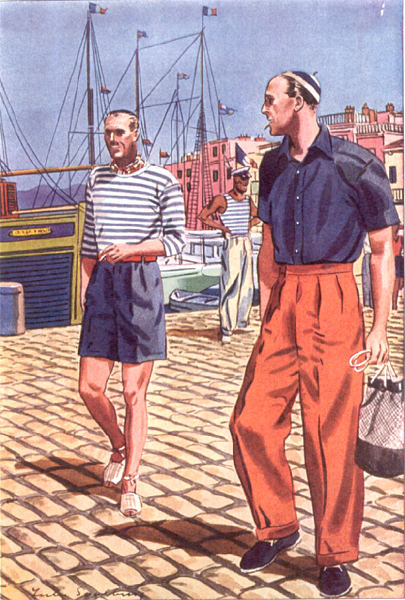
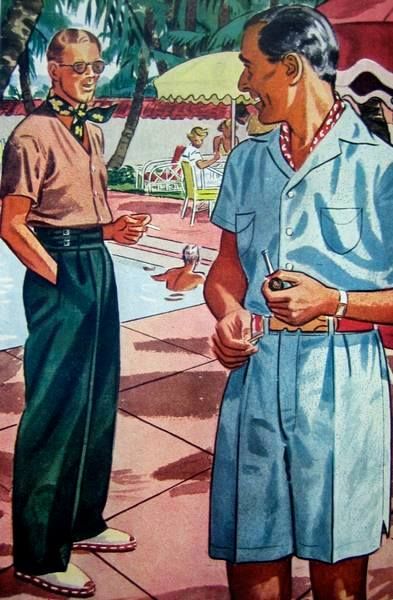
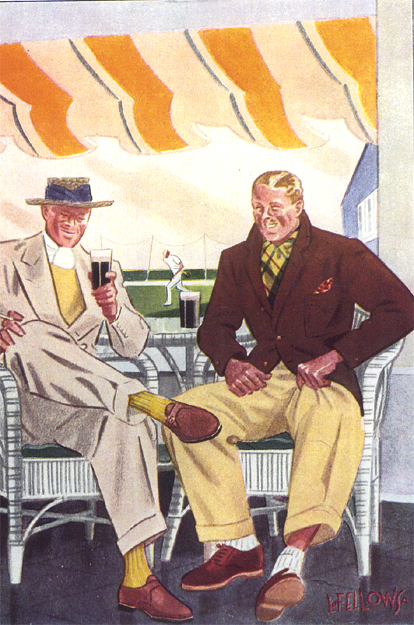
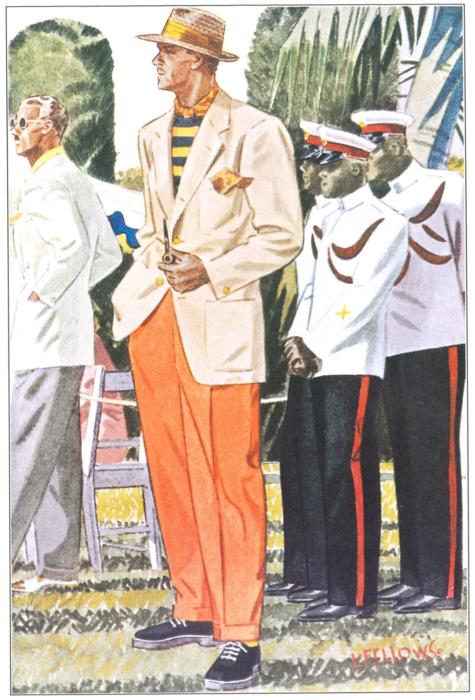
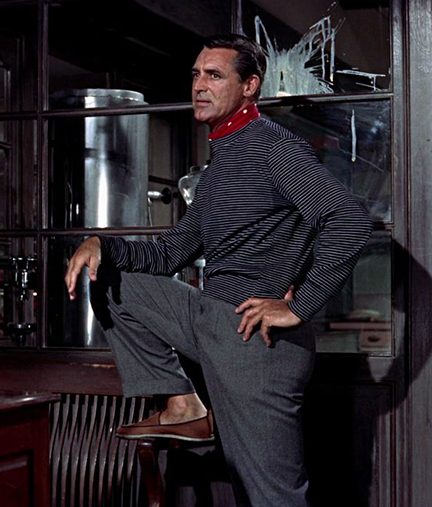
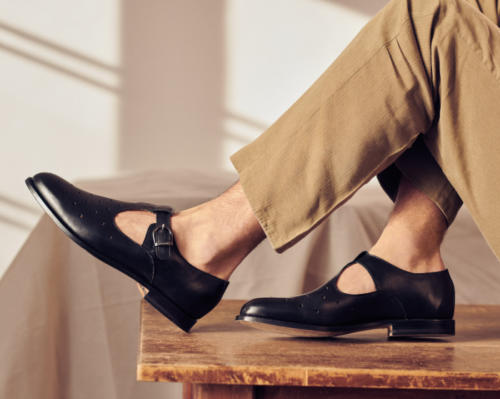
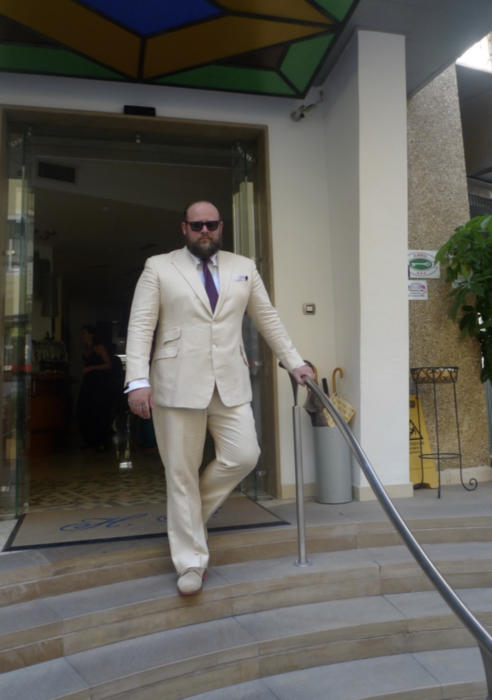
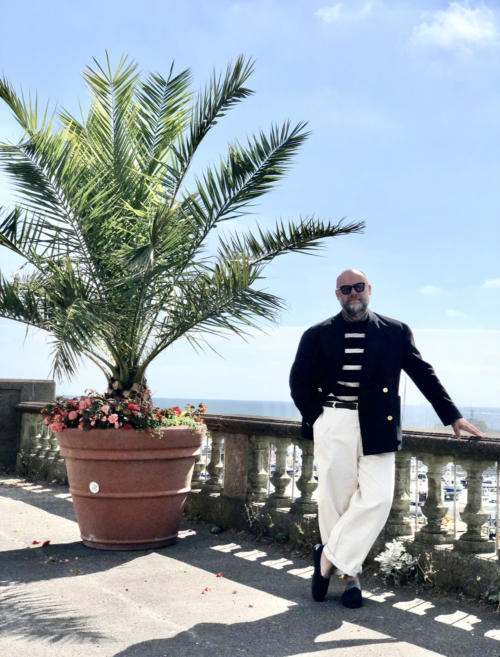


























Thank you for an excellent and very timely post. The illustrations are amazing, and I would also wear almost everything in them. What do you think was the main purpose of the neckerthief?
Philip –
Thank you for your feedback!
The neckerchief has a long storied history, much older than the modern tie, going back to (at least) Roman soldiers.
I imagine its practical use was similar to the way I utilise it: to keep the sweat off my chest from showing through my shirt and to keep my collar from discolouring in the heat.
Thanks a lot, Tony
I don’t know what other people use neckerchiefs for, but I like how they protect the skin on the back of my neck.
As I’m sitting in a departure lounge…
The focale (plural focalia), also known as a sudarium (“sweat cloth”),was a woolen or linen scarf worn by ancient Roman military personnel. It protected the neck from chafing by the armor and was used for warmth.
Greek hoplites also used them.
One of my new favourite articles, so thank you very much Tony! My personal style challenge has always been to take elements of this and incorporate them into my daily wardrobe.
On colour – YES! Just yesterday I was watching a French film with Alain Delon as a detective and admiring the serious monotone looks, but I just can’t resist colours like yellow or turquoise in summer. Of course these need to be in just the right shade or toned down in some way.
Regarding footwear tan bucks are a favourite of mine, but I really like the Crown Northampton Talbot. I remember you wrote an article about these for Crown so I’m sure you’re familiar. A particular inspiration here is Yukio Akamine, who often wears a similar looking shoe which I attached a picture of here.
Great piece, definitely a good inspiration for summer outfit. it was a very interesting era in term of many thing and style is not an exception. It’s nice to see the evolution of your style.
Few pulled of timeless Riviera glamour, sophistication and elegance better than the late great Sir Roger Moore – usually clad in (peerless) Doug Hayward bespoke tailoring coupled with bespoke Frank Foster Shirts….
Legend. Roger Moore looks good too!
Hi Tony,
As always an interesting and nicely written piece. I must confess too often skimming the photographs before reading the articles so was initially bemused by the second last picture. You look great in the last one.
Only thing missing on the footwear is a nice pair of grey NB trainers, but one can’t have everything.
All the best.
Ha! That’s a challenge! I’ll try and work them in…
The juxtaposition of the first illustration and the Drake’s ad is pretty great.
Good eye!
Really!
Manish not Manesh – nice post, thank you!
Nice article, it’s certainly an appealing era/ aesthetic. I wonder if there were anymore actual photographs from the magazines in question? Would be nice to see some as the illustrations of the day I never feel fully convey the truth of the time. I’m not sure if I’d describe the last outfit as free and easy. It obviously well put together but free and easy would suggest mor nonchalance which I feel is key to achieving the look effectively and I sounder if this one appears slightly over considered?
All the best -A
No photographs in those old publications alas, but the adverts give a good impression of the aspirations of the time…
“I delved into my somewhat dilettantish sartorial knowledge of the time and came up with a cream-linen suit from Mark Powell, with peaked lapels and a slight kick flare to the trouser, worn with a white penny-collared dress shirt, purple knit tie and tan bucks.”
No hiding behind modern photos,Tony ,you know we want to see this.
It was interesting how offen closed toe sandals were mentioned in casual shoes on Wednesday..
Peter –
It’s up there for you to enjoy, warts and all!
They say you learn more from your mistakes.
I wore an orange and lime polyester check jacket once.
Very much like the final outfit – any tips on sourcing similar trousers? Although as a shorter guy I wonder if they might overwhelm!
These are the white HBT Deck Pants from Bryceland’s, but for years I wore the RRL officers chinos in white..
Hope this helps, Tony
Thanks! Love Brycelands.
One ‘Riviera’ garment that feel quite modern and versatile is the knitted polo. It’s casual yet elegant and can easily dress up and outfit. In cream, navy, brown, olive or even stripes. It also have the added benefit of being easy to pack and fairly wrinkle resistant.
1930s and 40s Esquire is another source of brilliant illustations. En plus, they’re accessible in scanned form in the Esquire archive.
The websites of Ralph Lauren and Cheaney do not have have sandals. Church’s are an eye-watering £940 and Reiter’s Triestiners (with holes on the upper) are £629. Any other suggestions, ideally more affordable, for that style would very welcome. Paraboot’s more traditional Ferret are £268 but, unfortunately, they are Blake stitched.
Here’s the Ralph Lauren, but also very expensive. And nicer when they did it in black
Literally just bought a pair in the Harrods sale after reading this article. Saved £300…..or spent £400??
Nice!
F.lli Giacometti make some very nice ones, with a fully closed toe and two wide straps, but they seem to only be available in Japan (Simon: do you happen to know more about this maker?) and not cheap and mostly sold out.
However, here‘s a link for reference:
https://www.phaeton-co.com/?pid=167281239
I don’t I’m afraid, but I saw them in Japan a fair bit too.
Fabulous article. These are the styles I think about when I am lucky enough to go somewhere like Como or the Amalfi Coast (although my last time was pre Covid). They look as good today as they did back in the day as you point out.
It is a shame nice closed-toe sandals are so rare these days, I rather like the look of Church’s fisherman sandals. Unfortunately, it seems they have doubled in price since about four years ago, and just under £1k for sandals is a bit eye-watering!
Hi
This may have been asked before so forgive me if it has! I love this website. However, I’m a woman and therefore, it doesn’t really apply to me in many ways – do you perhaps know of a website or two that is like yours but catered towards women?
Best Wishes:)
Hi Erin,
I’m afraid it is asked quite regularly and I don’t know anywhere to recommend unfortunately
Hi Simon,
No worries at all:)
Frankly, every man in these pictures, and their hats, sport coats, and neckerchiefs in the Mediterranean heat, look ridiculous. Nothing here says “free and easy”—quite the opposite, in fact. The women look great though.
JJ, as ever it’s important not to take outfits as a whole, particularly when they are in commercial magazines and intended to show the most eye-catching of styles as well as mixes of styles that would never be seen together.
Focus rather on the little aspects and combinations. How modern someone in the top image looks in a knitted polo, tailored trousers and espadrilles, for example. Nearly 100 years later, and apart from the ties on the espadrilles, it would fit right in and look great. Equally something like the white bucks with the polo, a tucked-in breton, socks with espadrilles (how they were often originally worn) or how a canvas shoe can work with tailoring, if neatly styled
I hope it’s ok to ask here, Simon. On your Instagram recently, there was a photo of you in a dark suit with a party horn/blower. Which suit is this? Have you already written about it?
The shoulders of the suit frame your upper body well — sharp and distinct, but not boxy. Can you help me please understand what this type of shoulder is called? Is it an Italian, English, etc. characteristic? Is the shoulder padded?
Thank you,
It’s my Gieves suit covered here – if that article doesn’t answer your questions, do feel free to ask a question there
Thanks Tony for a really interesting article. I’m interested in your (and Simon’s) thoughts on who you see as the best modern day exponents of riviera style? I always think Alexander Kraft manages to capture the essence of riviera style well in the way he dresses. Would you agree and who else might you point towards? With best wishes.
I would say Adam Rogers, founder of Adret, has the relaxed and elegant look down to a tee.
Robert Rabensteiner, the old editor at L’uomo Vogue, is a powerful dresser and takes summer on the med in his rather colossal stride.
Meanwhile,in the Nederlands , PS Riviera having an influence.
RTW, but so comfortable
Pleats. Everyone wore pleats! We need pleats.
Love a neckerchief and have bought several over the years. Yet to wear one outside of the house though! Not for want of trying but every time I get to the front door I take one last look in the mirror think “too much”. Maybe in a few years when I have more grey hair!
There is no mention of mess jackets that is complete without this great clip from Jeeves & Wooster: https://youtu.be/SYf5YPNnfRY?t=27
Followed by this clip from Jeeves & Wooster: https://youtu.be/oBbT7WRlDwQ?t=468
Love it. Thank you Adam.
Particularly the way Bertie refers to the more flashy of items as ‘snazzy’ or ‘snappy’. A friend of mine always refers to shoes that are rather too flash as ‘spicy’. All words for the same thing
An interesting historic point. “Palm fibre” (first bullet point, about through the article) is likely a reference to palm beach fabric, a mohair-cotton blend fabric patented by an American company, Goodall Worsted Co. It was a popular fabric for summer suits, jackets and trousers in the US during the 1920s-40s. It was often marketed as a suit that could be worn as both separates and as a full suit. It feels similar to a heavy wool/linen blend with a hopsack-like weave. Not quite as breathable as pure linen but holds its shape better and with enough texture that it would work as both a suit and separates.
While palm beach fabric is no longer made, I would say the idea of a warm weather “three way suit” is as adaptable to a modern summer wardrobe as much of the rest of the Riviera Style shown here.
I didn’t know that, thank you very much Alan
Always a pleasure to share obscure bits of vintage clothing knowledge where other people might appreciate it. This is a 1930s Palm Beach jacket I bought years ago. Unlike most tailoring from that era (which tends to have thick canvassing very built up shoulders) it has only a very light layer of chest canvas and completely unpadded shoulders. It actually makes for a very wearable summer jacket, I just struggle with how to wear it in a way that will look modern and not out of place in the UK.
And here’s the picture I forgot to attach to my comment.
It looks lovely Alan, but yes I can see how it would be a struggle. I’d say wear on a sunny day, perhaps unbuttoned most of the time, with a shirt or T-shirt (maybe denim) and dark trousers. Other kinds of cream jacket combinations here
Love the images Simon. Always striking just how elegant the gents in these pictures look, would it be fair to say proportions are playing a large role here? Those wide trouser legs combined with the clean and close waist lines?
Yes, absolutely. Being illustrations, everyone is also drawn with a thin waist and broad shoulders, tall and erect. Wider trousers and higher rises then accentuate that too
Cheers Simon, yes I should have led with that, being illustrations as they are naturally they have ethereal proportions. However, always like to think all of us guys, regardless of shape, can take pointers from images like this, nudge ourselves a little closer to that golden ratio, even if it’s only a subtle move.
Absolutely, it makes a difference to everyone
Talking about images I could not help noticing that the hotel pictured in the article is the Grand Hotel du Cap Ferrat and not the Hotel du Cap in Antibes.
Oops. Thank you Laurent
Great article and a subject I feel is very relevant. Warm weather holiday seems to be the occasion people nowadays care least about how they look.
For my honeymoon in Aruba years ago, I wore tailored linen trousers (sand) with white canvas sneakers or espadrilles, linen shirts or a unbranded polos in the evenings for dinners and drinks. I was very comfortable and importantly (to me at least) was on a similar level of formality with my wife in her summer dresses.
I’m sure we stood out among most other couples, where in general women made an effort and the men wore flipflops and board shorts. But apart from my own enjoyment of nice clothes, I’d like to think that sort of thing is appreciated by the people working and providing great service for the guests too.
Sounds great JB
Amazing article Tony! Very interesting read. I have also had an habit for sourcing some nice looks from the legend Fellows illustrations. A question, The last picture I see you sporting a great Breton. Who is the maker? Do you have any Breton favorites in todays marketplace?
Max –
sorry for late response here.. it’s from Margaret Howell. I really like how they add more earth toned stripes in their collections – suits my wardrobe a lot more.
I loved this article, in part because I’ve been an admirer of the style, but also because, honestly, I’ve never really been able to master it. On the rare occasion, I do manage to get a holiday in France or Italy, I always pack with the best of intentions – Neopolitan jackets, linen shirts, Rota chinos etc. However, due to reasons usually associated with practicality and comfort (and my habit of walking everywhere) end up always end up falling back on a stripey t-shirt with a chore jacket, which looks great in a Southwark pub, but in Genoa or Collioureou might as well light a Café Crème, board the nearest tug and learn the art of spear-fishing.
It’s great to see you’ve clearly found a way to master the look, but doubly admirable that you show it takes time and experimentation.
About the „black fresco blazer“: I suppose that means this is a suit material? I often see „high twist“ or „fresco“ materials sold as a sport jacket. I don’t think this would work for me. Do the gold buttons transform this into an odd jacket, no matter what the material?
I think Tony and I might differ a little on how much those high-twists should be used as jackets, though his does look good on him. The gold buttons certainly make a big difference
One thing I really appreciate in the images presented is the width of the trousers. They allow for an attractive drape and they are much more comfortable then the slim fit we have been accustomed these past number of years.
True in general and specifically in regards to the heat and ease of clothes like these I think